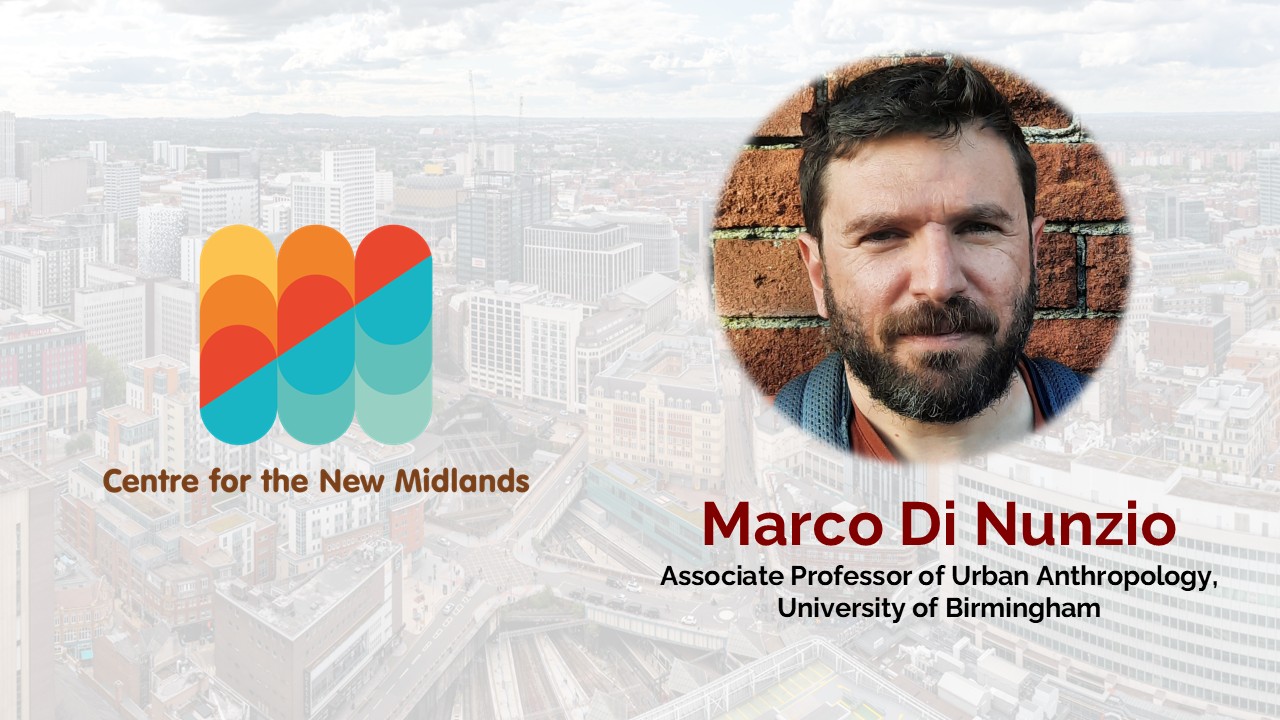Birmingham City Council has hailed the Ladywood Estate Regeneration Scheme as “the city’s most significant housing redevelopment opportunity in a generation,” promising £2.2 billion of investment over 20 years.
In this article, Marco Di Nunzio (Associate Professor of Urban Anthropology, University of Birmingham) interrogates what is at stake when a regeneration risks overlooking the profound meaning of ‘home’. In this context, community engagement cannot be reduced to box ticking exercises, surveys, or meetings if these are not accompanied by real opportunities for residents to affect the future of their neighbourhood.
(June 2025)
A home is not just a physical, built shell where we live. It is where we dwell in the world. A sense of home provides comfort, grounding us in a place through a deep emotional and existential connection. We feel at home “when what we do has some effect and what we say carries some weight”[1]
Not feeling comfort at home is troubling. It disturbs our sense of belonging, everyday rhythms, and ability to shape our surroundings. Living in unhealthy housing affects our mental and physical health. And losing a home undermines our ability to establish a predictable world in which to ground our actions in the present and imagine the possibility of a future.
I have been conducting research on housing in Birmingham since 2023 and globally, with a focus on Southern Europe and Eastern Africa, for over two decades. As I have followed the unfolding of the Ladywood regeneration, and the threat of displacement facing over 1,900 households and 5,000 people, I have often been reminded of the depth of our connections to home, and, ultimately, of a lesson that local government and political representatives have repeatedly failed to learn.
A home is not just an asset, and the security of inhabitation and dwelling cannot simply be transferred as people are moved from one physical shell to another. A sense of home is built over decades of inhabitation, as we build familiarity with our surroundings, as our neighbours become known faces we trust, and as our home becomes truly ours through living in it.
A sense of home is an achievement—often a hard-won one—made even more difficult today, as having a home has become an ever more expensive endeavour. The costs of owning, renting, repairing, and maintaining homes have been pushed onto individuals and families at a time when the retrenchment of social services, the rising cost of living, and the erosion of labour rights have severely undermined both individual and collective capacities to achieve social mobility and shape the decisions affecting their lives.
The story of the Ladywood regeneration, and the ongoing struggles of its residents, can only be understood if we recognize the profound importance of home.
The regeneration was officially launched in February 2019, without much public scrutiny or community involvement. The threat to over 1,900 homes has been shrouded in a democratic deficit.
Residents were not involved in the long-listing or shortlisting of potential options for the redevelopment of the Ladywood Estate. If consultation sessions were held—apparently two—there is no public evidence of when these meetings took place, who was invited, how many attended, or whether these were genuine workshops enabling residents to influence the scheme, or merely informative sessions.
When the regeneration became widely known to the community, it was possibly already too late. The regeneration had suddenly become a reality.
On June 27, 2023, Birmingham City Council (BCC) voted to award the regeneration of the Ladywood Estate to St Joseph, a subsidiary of the Berkeley Group.
A month later, on July 20, the ward councillors, BCC officers, and representatives of Berkeley held a meeting with residents, from which hundreds were excluded as the venue was too small to accommodate them all. “I saw the councillor closing the door in my face,” a resident in her twenties told me.
Since then, the messaging from the council and the developer has remained the same. Residents will be consulted on the future of the neighbourhood—but no process of any relevance has been set in stone.
Yet, something had been set in writing. The report that the Cabinet voted on in June 2023 to award the contract to St Joseph laid the groundwork for the demolition of homes as well as businesses, community facilities and religious buildings. It approved a Compulsory Purchase Order (CPO) in principle. The council had “decided that, on balance, it is in the general public interest and of benefit to the community to make the CPO [compulsory purchase order] over and above the interest of the individuals affected.”[2] To justify this view, the report used self-reinforcing language, emphasising the benefits of the regeneration while minimising any discussion of its negative impacts on the community, including on the elderly and those with disabilities
After reading the report, residents felt concerned and angry. Many were worried that the council’s and developer’s vision for a regenerated Ladywood left little room for the existing community.
628 council-owned homes in Ladywood’s seven towers—long overdue for repair and maintenance—will be only partially refurbished. The remaining 638 council-owned homes and 146 homes owned by registered providers will be “re-provided” – a measure that may involve demolition, causing significant distress for over 700 tenant households. The future of around 600 leaseholders and freeholders is equally uncertain. They may either face compulsory purchase, with compensation that could price them out of the area, or be offered a shared ownership/shared equity scheme that would leave them financially worse off.
Meanwhile, religious buildings are due for demolition to be replaced with secular buildings, and businesses potentially risk losing access to a central location as a result of the regeneration.
All of this is to make way for the construction of over 7,000 homes to be sold on an ever more expensive housing market, of which only 16 will be classed as “affordable” – a figure likely to decrease further upon completion, as its delivery is subject to the developer securing a 20% profit margin.
Notably, the report made no mention of social rent or social housing.
In the months that followed the publication of the Cabinet report, the council promised to rebuild trust, conducting engagement and consultation sessions aimed at drafting a Residents’ Charter—a document listing the council’s commitments to residents. Yet the way these activities were conducted only deepened residents’ suspicion of the council.
BCC held 12 engagement workshops in October and November 2023. Participation was capped at only 20 participants per workshop, limiting opportunities for meaningful and inclusive engagement.
Moreover, the activities carried out at these workshops were not sufficiently or appropriately designed to produce such a charter. The workshops began with the council’s representatives delivering an overview of the project, followed by group sessions aiming to elicit participants’ concerns, possible solutions, what they valued, and what they wished to know more about. Participants were asked to add sticky notes and comment on any promising ideas on large pieces of paper.
From the outset, the workshops were presented and designed as information sessions rather than hands-on activities focused on producing a clear output. The questions asked were generic, and the methodology used to elicit responses vague.
A survey was then launched a few days before Christmas 2023, running until the end of February 2024. Structured in four parts, the survey invited participants to state their priorities on a range of topics, including trust, the importance of community involvement, compensation, rehousing options, parking, and green spaces. Four videos accompanied each section, detailing the range of feedback and suggestions BCC received in its workshops. However, the clustering of so many topics into one survey and the lack of clarity about how the feedback would be used remain causes for concern.
Workshops held in June and July 2024 focused on the community charter, but residents were not given access to the draft charter that the council had already been working on, limiting their ability to influence the process—or even give targeted feedback.
A new survey was launched in August 2024, closing in December 2024. In this second survey, residents were not invited to comment on the Strategic Narrative, the section that outlines important principles that should be subject to consultation and public scrutiny. There were also significant discrepancies between the specific demands outlined in the “What We Know So Far” section and the commitments presented in the Residents’ Offer within the Charter.
Residents were told that one of the Charter’s key aims was to reflect their priorities and aspirations. Yet many felt that these priorities have largely been decided by council officers who, as one admitted during a meeting with community representatives, had “cherry-picked” residents’ feedback.
The signing of the development agreement between BCC and St Joseph/Berkeley Homes, formally announced on April 30 this year, opened a new chapter in the regeneration. In their communications, the developer committed to turning a new page and pledged to win the trust of the community.
The offer to provide 20% affordable housing, minimise demolition, establish a Steering Committee, initiate the long-awaited procurement for an independent advisor to support the community, and hold another round of consultation before finalising the Residents’ Charter was presented as a step in that direction.
But too many unanswered questions remain. How will members of the Steering Committee be selected? Will the residents’ Steering Committee have decision-making power? Will residents be given seats on the Ladywood Project Board? What criteria will be used to select the independent advisor, and how will their independence be guaranteed? Who will define the remit of the advisor’s work? Will the advisor support residents in challenging decisions that adversely affect them, or simply provide advice on decisions already made by BCC and the developer?
And then, will residents be simply consulted or directly involved in designing Ladywood’s masterplan? Are the religious buildings still at risk of demolition? Will the community’s unconditional right to return be enshrined as a core principle of the regeneration? What will happen to the council tenants living in Ladywood’s seven towers while their homes are being refurbished? What arrangements are in place for the council tenants currently living in the 638 homes scheduled for demolition and reprovision? Will residents affected by demolition be given a good-quality home without additional costs and without being worse off? What will the terms of ownership and rent be for the new homes in a regenerated Ladywood? Will homeowners and leaseholders affected by demolition be offered a like-for-like replacement? What are the proposed percentages of social rent, low-market rent, and shared ownership within the new affordable housing? Is the proposed provision of 20% affordable housing subject to viability?
Since 2019, residents’ sense of being at home has been trampled on, their right to their own home neglected. A regeneration has been imposed on them, with profound consequences for their lives – and without giving them the space and time to meaningfully shape decisions.
Over the past two years or so, I have met residents who would much rather spend time with their families, friends, and neighbours than sit through consultation sessions, read policy documents, and fight – again and again – to have their voices heard.
I have met leaseholders and freeholders who would much rather enjoy the homes they have built, lived in, and, importantly, paid for through decades of hard work.
I have met council tenants who would prefer the council repair their homes, clean the mould, and ensure the lifts work, instead of pouring time and resources into plans to demolish their homes – or those of their neighbours.
In response to these concerns, I have heard council officers committing themselves to improving their practice as a way of redressing past mistakes. This is an important step, but it is not enough if decisions continue to be made presumptuously in the name of the community without giving residents a voice, or dismissing community groups and concerns that challenge the council and the developer as not being “representative.”
Good practice cannot be reduced to box ticking exercises, surveys, or meetings if these are not accompanied by real opportunities for residents to affect the future of their neighbourhood. Residents’ voices do not constitute mere “feedback” to be considered at the discretion of the council or the developer — residents’ demands are binding principles that the regeneration must abide by.
Ultimately, one thing is clear: when a sense of home is at risk, the stakes cannot be higher.
[1] Jackson, Michael. 1995. At Home in the World. Durham, NC: Duke University Press, p.123
[2] Ladywood CPO Human Rights Considerations. Appendix 9: 8.1
This is a personal blog post. Any opinions, findings, and conclusion or recommendations expressed in this article are those of the authors and do not necessarily reflect the view of the Centre for the New Midlands or any of our associated organisations/individuals.
ABOUT OUR AUTHOR:
Marco Di Nunzio is an Associate Professor of Urban Anthropology at the University of Birmingham. He is the author of The Act of Living (2019, Cornell University Press) and Unjust Developments (forthcoming, Fordham University Press), and the director of the award-winning documentary A Day in Arada. Marco is also the founding editor of OtherwiseMag, a magazine of ethnographic storytelling, and co-lead of the Housing-Led Regeneration research group. An exhibition of his research on demolition and urban space was held at CENTRALA in May 2024.








